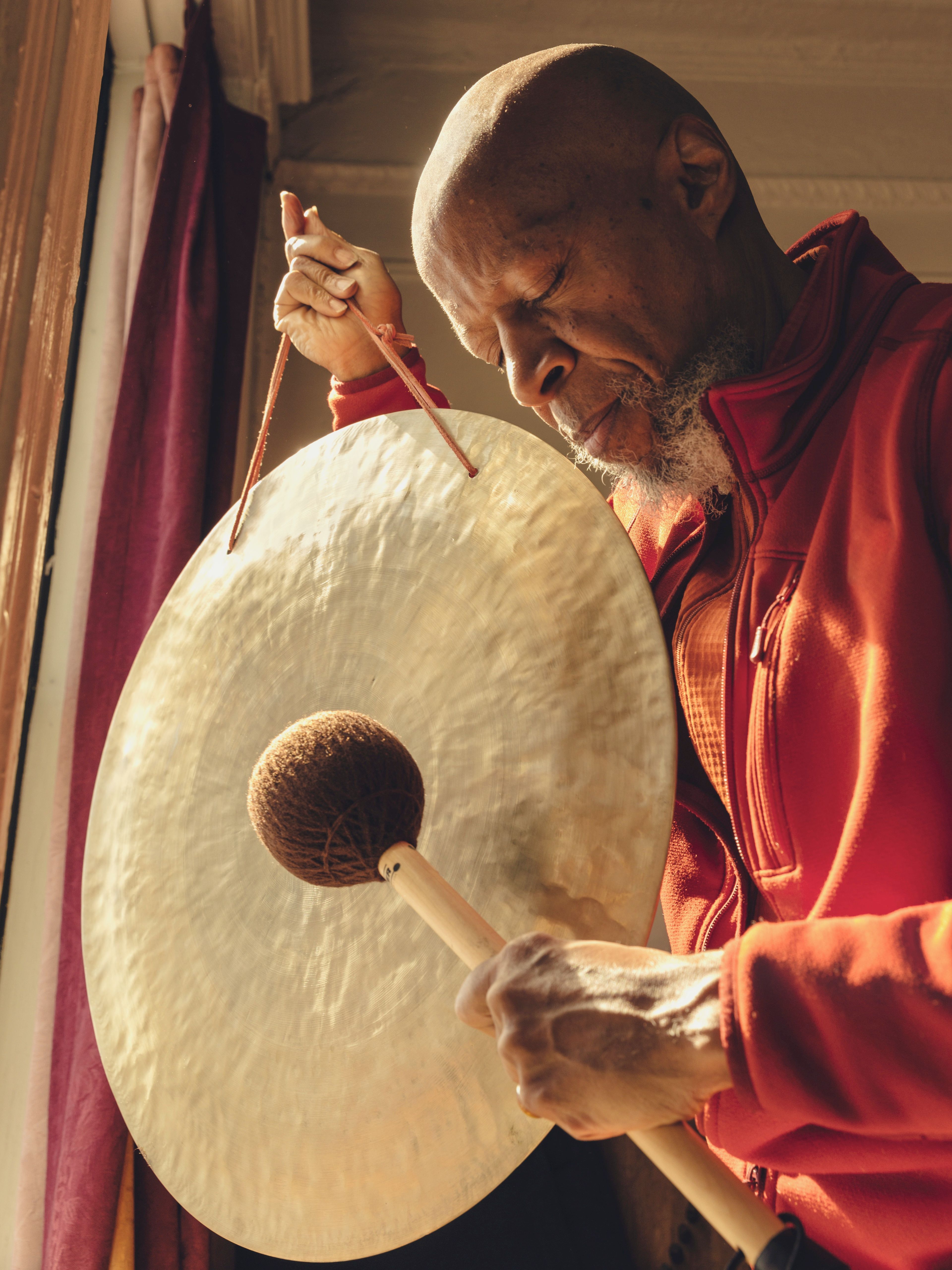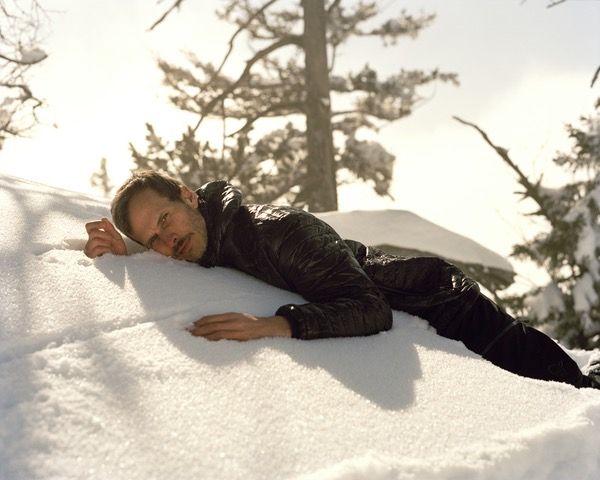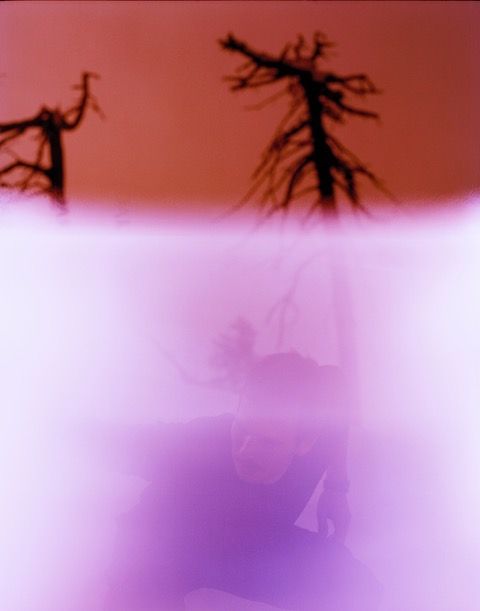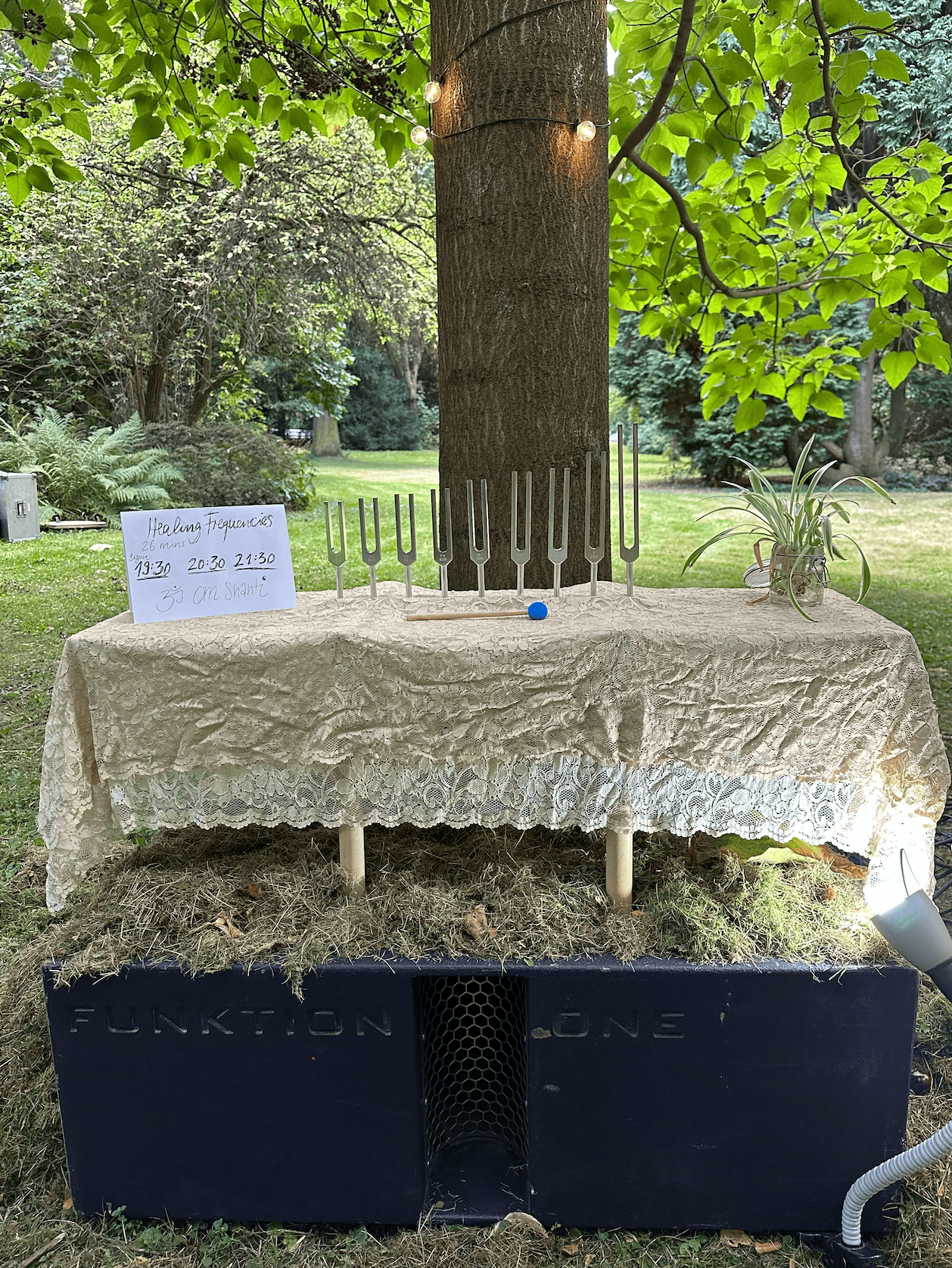Treat me like your patient – old and new sounds for healing

The belief in the healing power of sound - with Albert Ayler, Sun Ra, Laraaji, Alice Coltrane, Pharaoh Sanders, Kahil El'Zabar, Hendrik Weber, Lincoln Jesser & Maria Wildeis
The last album by free jazz revolutionary and saxophonist Albert Ayler was entitled “Music Is The Healing Force Of The Universe”, back in 1970. The fact that music could be a, if not THE “healing force” for people, the community and the world was not really up for debate at the time. And why should it be? Although pop music had only just begun its triumphal global march, was compared to today's standards still in its infancy. But jazz and soul, the former always bordering on “serious music”, the latter at home as the studio-based industrial heart of pop, proved that as the soundtrack of the civil rights movement (together with political action, protests and self-empowerment) it could soften and sometimes heal the wounds of damaged lives after slavery and in segregation. Above all, music offered a hitherto unknown pathway out of ghettoised neighbourhoods and into the wider world. Not only as a career, even if more and more African Americans were drawn into the cultural fields, but also as a distinct Afrofuturist vision.
For Ayler's colleague Sun Ra, relief came from a speculation about, and assertion of, an alternative life in space: “Space is the Place”. While planet Earth was cursed and burned as the home of slavery, Jim Crow laws and violence against black people, the right sounds were an invitation to leave country and planet behind. This vision came from someone who should know; after all, Sun Ra grew up in Birmingham, Alabama, for many decades the most segregated and brutal city in the USA.
This new potential emancipation was often celebrated in long concerts, which sometimes took the form of the church service that the black population of the USA called their own: gospel. Gospel and its choral music based on mostly simple pentatonic patterns of the blues scale, which was not perceived as frontal instruction but as a communal, vocal-musical, spiritual experience, had another function in the communities in addition to contact with God: Singing together against the injustices of life, healing each other – community building. In the form of the new Black music forms, this practice was freed from its local limitations and made available everywhere as a quickly administered medicine in the form of sound carriers (or as a traveling band).
Ayler soon had to experience for himself that music could not save everyone, because the great promise soon turned out to be a cynical joke on the world. And so, shortly after recording the album, Ayler disappeared under mysterious circumstances and turned up dead three weeks later in New York's East River. He would certainly be proud of the fact that over the last five decades, that belief in the healing effect of sound has retained a place across the most diverse corners of the music world, given new life time and again.
The yogi plays the zither: Laraaji
You don't have to look far for traces of this era, because some of the musicians of that healing epoch are still at work. The new age jazz of New Yorker Laraaji has been openly embodying the healing powers of his music for over 40 years. With him, as with modern representatives of “healing sounds” – who, as we will see later, have other musical roots, come from other movements, use other techniques and also pursue other ambitions – there is a strong influence from South Asian schools of thought; especially from the Vedic religion, its successor religions and philosophies (essentially Hinduism) and Brahmanic yoga teachings.

This influence can already be seen in the jazz musicians of the golden era of the 1960s, with Alice Coltrane (Swami Satchidananda from 1970 and later Sathya Sai Baba) presumably the best-known representative. But clear traces of this spiritual influence can also be found in Pharaoh Sanders, who as a “student” of John Coltrane maintained direct contact with his wife Alice. However, while the word “love” comes to the fore early on with Pharaoh Sanders – and undoubtedly has a function comparable to that of the word “healing”, which is central to this article – there is no direct link between Vedic ideas and musical content. This is not the case with Laraaji, whose work, both musically (in the moods of the instruments, especially the characteristic zither) and extra-musically, for example in the form of song and album names, is always permeated by an idiosyncratic interpretation of the healing powers of yoga and the ecstatic singing/playing of mantras. If the direct reference to healing effects has diminished in recent years, these were particularly clear in the 1980s: the Laraaji albums in this phase were titled “Connecting With the Inner Healer Through Music”, “I am Healing” or “A Tape for Emotional Cleansing”.
Interestingly, and not uncommon for new age musicians, Laraaji shifts the act of healing into the individual; until then, it was primarily aimed at the ceremonial aspects of shared history, experience and tradition, and it was about building a community. With Alice Coltrane and other representatives of the first spiritual jazz generation (Gary Bartz, Sun Ra, sporadically also McCoy Tyner), the emphasis was still on community building – familiar from gospel – and the collective experience of both suffering and relief.
Inner repatriation as a black healing strategy
Although no longer part of the first generation, and perhaps never really absorbed into spiritual jazz, Kahil El'Zabar from Chicago is currently experiencing a renaissance as a musician who himself has had contact with music as a healing force, not least with his 2020 album “A Time for Healing”.
In El'Zabar's case, the link to Vedism is completely absent. Instead, since the early 1970s he has been pursuing a philosophy that could be described as “healing through (inner) repatriation”. El'Zabar's ideological approach is accordingly called “Traditional African Music and Philosophy”. “TAMP” is based on the teachings of Harold Murray, known as Black Harold or Atu Murray, another musician from Chicago who, after a trip through Africa, preached an update of the “Back-To-Africa” idea of the early 20th century - in Murray's case only intended as a cultural return and not as actual resettlement. Here the “healing” takes place through a continuous and constantly reproduced connection to the “forefathers” on the African continent. The experience of being Afro-American (or African American) is therefore the wound, the illness from which it is necessary to recover. This is a view that connects Murray and El'Zabar directly and indirectly with musicians from the Art Ensemble of Chicago as well as the Pyramids (aka Idris Ackamoor & The Pyramids). It is also possible to build a bridge to the roots movement in Jamaica, which pursued a similar idea of spiritual, cultural and physical repatriation at the same time.
Fuelled by several reissues and rediscoveries of the aforementioned musicians, and not coincidentally coinciding with jazz’s new prominence, a new generation of musicians has developed since around 2010 who have found either one (Vedic) or the other (Black or African American or post-colonial) approach to the idea of music as a remedy.
Confronted with racism, exclusion and violence to this day, artists such as Andre 3000 (“Visual Healing”), Shabaka Hutchings (“The Healing”; his group Sons of Kemet is explicitly described as a “vehicle for healing from colonialism”) and the French flautist Naïssam Jalal are also longing for relief.
But jazz-related musicians are no longer alone in exploring these ideas. Healing is now being practiced everywhere, trauma is being countered and peace of mind is being promised. Back in 2017, Pitchfork.com asked the question “Can Music Heal Trauma?”, while other media outlets such as Resident Advisor and the German public broadcasters ARD and Arte followed up with articles and programmes on related issues. Bandcamp Daily has published at least eleven articles on artists and their healing music in the last seven years. (Examples: Fumio Miyashita's Journey from Martial Arts to Prog to Healing Ambient Music or For Legendary Vocalist Yungchen Lhamo, Music is Made to Be Healing)
Under the label “healing” you’ll find there are constantly evolving and growing trends, artists and subcultures. Parties dedicated to the supposedly healing frequencies of the mystical ‘Solfeggio series’ are becoming briskly popular. Meanwhile, the terminology also morphs and grows, constantly embracing related phenomena. Sometimes it is called “healing through sound”, elsewhere “stimulation of the body's own defences through sound” and so on.
Here the approaches and ambitions vary: there isn’t just one group of people who deal with “sound and healing”. There are classical music therapists, then established music producers who dedicate themselves to certain frequency ranges; rituals, ceremonies and shared experiences; sometimes with, sometimes without singing bowls and dream drums. The eurythmy therapy of anthroposophy (according to Rudolf Steiner), which was once ignored and/or ridiculed by society suddenly appears where just a few years ago techno and house music were the authorities setting the hedonistic tone at festivals.
Music therapy as a science, healing as a sham?
The effect of music therapy in the care of people with traumatic brain injuries and lesions has long been sufficiently described and proven, as has the effect on patients with Alzheimer's disease and dementia. Music is a very direct medium that, unlike written text, photography or even film, does not require attentive examination, but triggers emotions and appeals to regions of the brain at a very basic level. Music usually works on its own, and through the stimulation of our largest organ, the skin. Although this has been long established by studies and many years of practice, the boundaries between “conventional medicine” and alternative healing methods (naturopathy, TCM, but also esotericism and quackery) become blurred very quickly.
Defining healing remains hard, as even scientific medicine still adopts different definitions of “healthy” and “ill”, which in turn compete with legal definitions and meanings. Is a conclusive, exhaustive definition of the far more complex term “healing” even possible?
The musician Hendrik Weber defines this for himself as follows: “Healing or being whole means for me when I am allowed to be completely ‘there;’, in community with all my experiences, pains, moments of genius, failures and lovable sides, but also with the dark and contradictory, and it is still allowed to continue to flow and change. When everything that defines me as a human being is moved and allowed to find expression, I feel that healing happens. When thoughts, body, movement, art and music can flow freely through life, then I find that healing.”

Soothing frequencies from the record bell: Hendrik Weber
Weber, who had success in the 2000s under the pseudonym Pantha du Prince with elegant, romantically soulful deep house, demonstrated an influence from natural sound experiences on his latest two albums, “Conference of Trees” (2020) and “Garden Gaia” (2022). In between, in 2021, he also released an LP, “429 Hz Formen Von Stille”, under his real name. The press release spoke of “sonic medicine in the best sense”. Eleven mostly ambient tracks feature, soundscapes each led by particular musical instruments: bells, strings, zither, to name but a few. In terms of music theory, the pure tuning of Weber's plate bells “sets the tone”. Instead of the standard 440 Hz (Hertz), the basic tuning here is lowered to the frequency of the frequency of 429 Hz. Building on this, Weber plays in a pure overtone tuning, which is more harmonious in itself, tuned to the nearest cent in “natural tones”. “This is a mathematically very fine and precise approach.”
This focus on the scientific and mathematical mechanics of harmony is no coincidence, but part of a trend that has developed over the last four years in particular and gaining followers. A large, if varied scene has emerged that tunes its instruments (where possible and necessary) lower (and more “naturally”) than we are used to in the USA or Central Europe. The term “solfeggio”, mentioned earlier, appears remarkably often in this context. Originally merely describing a form of listening and singing exercises, “solfeggio” has become a buzzword in its own right, one that has taken on a life of its own.
A whole range of theories are gathered under the word solfeggio. What they have in common are various speculations about the European tonal system and its fixation on concert pitch which is clearly above the normal level of a natural or atomic/molecular world. As Hendrik Weber puts it in an interview: “I perceive 440 Hertz as agitational, effervescent and exciting. A faster basic wave runs through the room, and the detuning of the overtones in the well-tempered A440 Hz tuning also creates an inaccuracy in the frequency spectrum. This allows classical European music its chord changes [...], but at the same time is slightly mathematically incorrect and thus has a more energising effect.”

Between the chakras with Lincoln Jesser
In this insight, Weber is not alone. On Reddit, in blogs and on the Instagram pages of musicians across the spectrum, there are numerous comments that support this claim. Two labels have now been established for this social phenomenon: Solfeggio-Community and 432-Hertz-Community. Surprisingly (or perhaps not so surprisingly), there is no current consensus on which alternative is the most “healing”. However, it seems to be undisputed that a new “keynote” is needed - depending on who you talk to, this is either 432 hertz, 417 hertz or 429 hertz.
The only thing everyone agrees on is that “normal music” has NO healing effect, and sometimes even harms us; new music, on the other hand, is healing, according to the community, whose superstar is Californian Lincoln Jesser. Jesser emerged on the music scene around 2013 and produced pop and vocal house that was clearly influenced by electronic dance music in the early years. When success failed to materialise, Jesser specialised in a quieter, more minimalist and, if you will, more tribalistic style of electronic music. You will search in vain for sophisticated sounds, but Lincoln Jesser has nevertheless managed to build a fan base around him. He increasingly claims to be able to heal with his music and, if you believe him and his striking, guru-like appearance on Instagram, has trained in meditation and breath work, and has a spiritual connection to nature. He also claims to have studied various forms of yoga and ‘energy purification’. More than half a million people now follow Jesser on Instagram alone.
It is worth taking a closer look at his profile, as new forms of “cleansing” and healing are constantly being introduced, new frequencies are defined as healing and of course the term “solfeggio series” also appears. For Jesser and other representatives of the guild they link solfeggio to the chakras of the human being. Accordingly, either 417 Hz or 432 Hz is the frequency of the heart chakra, 528 Hz is that of the solar plexus chakra and so on.
This numerological mysticism is refreshed by a new, unique way of community building: parties here become ceremonies at which everyone should come dressed in pure white and chemical drugs, for example, are forbidden.
Maria Wildeis: Skeptical of yogi, business influencers and telly evangelists
“These images look familiar to me because I went to various ashrams with my mother as a child,” says musician and artist Maria Wildeis, who has studied the Solfeggio series. In her installation “Healing Frequencies (Now in 4k!!!)”, which she set up in the park of the Düsseldorf artists' association “Malkasten” in the summer of 2024, she found an ironic form of thematization: a sound collage sounded every hour from a system from the manufacturer Funktion One, “idolized” since its installations in Berlin's Berghain, which stood here like a worshiptable altar in the art park. What initially seemed like instructions for a yoga class gradually unfolded into a panorama of found snippets from the depths of the internet. She herself writes: “Hertz numbers of the Solfeggio series such as 108, 417 and 528 or the 777, 222 or 423 were appointed by European yogis, business influencers and telly evangelists as the new, epiphanic icons in the holistic online healing business.”

In the interview, she explains that she is primarily interested in pursuing the construction of sound; as a musician and theorist, she already dealt with the epistemological nature of sound during her studies at the Düsseldorf Institute for Music and Media: “The determination of the 440 Hz concert pitch in Europe was preceded by political decisions and historical events. It is, of course, an arbitrary determination that does indeed have its problems. For singers in particular, the concert pitch a is a difficult setting. It is actually too high."
At the same time, she’s skeptical towards most music ‘healers’: “I find it very entertaining to deal with these types, but for me, dealing with the ‘Solfeggio series’ is mainly charlatanry and false prophets.” In the community, which is made up of alternative medicine practitioners, esotericists, free church members, business people, self-optimisers, there is a great longing for truth. According to Wildeis, more and more people feel alienated and want to become “one” with themselves again. Simple and quick answers, comparable to those of homeopathy, are thus welcome. In this way, a community emerges again that offers a “new meaning”.
It is not surprising that the new hype is also driven by the same motives as the originators of spiritual jazz: ultimately, it is probably more about community building, about the feeling of not being alone to endure the calamities and pains that a world designed like ours presents. Over the last 60 years, people have returned to religion, yoga, esotericism, spirituality, and, of course, to music. The core principle of therapy probably applies: “What helps, helps.”
Written by Lars Fleischmann
Lars Fleischmann is an author and journalist, who writes regularly for taz, konkret, kaput-mag and others about art, pop and jazz. Fleischmann works also as an editor for Cologne’s local magazine Stadtrevue. While writing this article, he thought on more than one occassion about Radiohead’s line from “There There”: Just cause you feel it, doesn’t mean it’s there.
Cover photo: Lajaari © Nathan Perkel, Record Culture Magazine
This article is an EM GUIDE special curated by the editors of the EM GUIDE members and created in response to current trends and issues of the regional and global music industry.